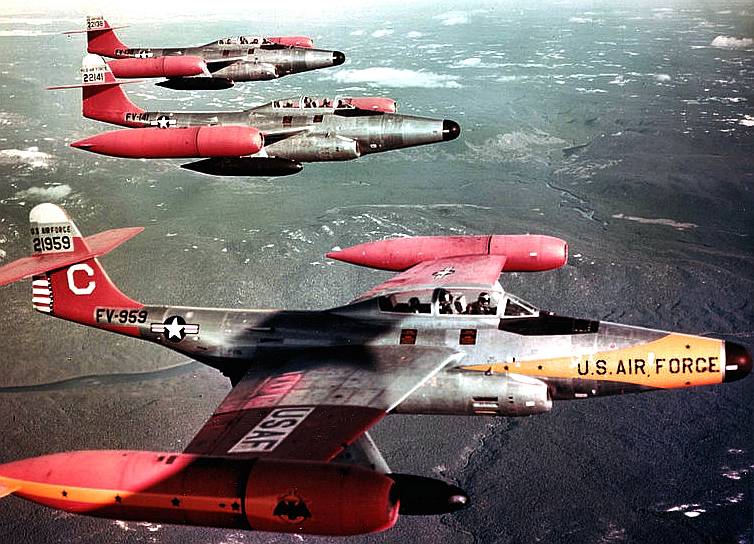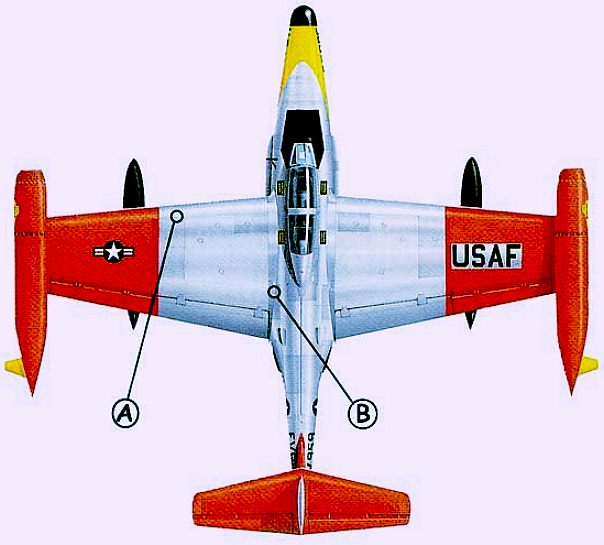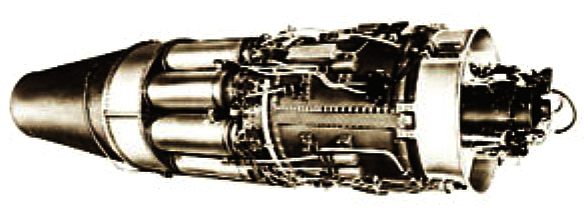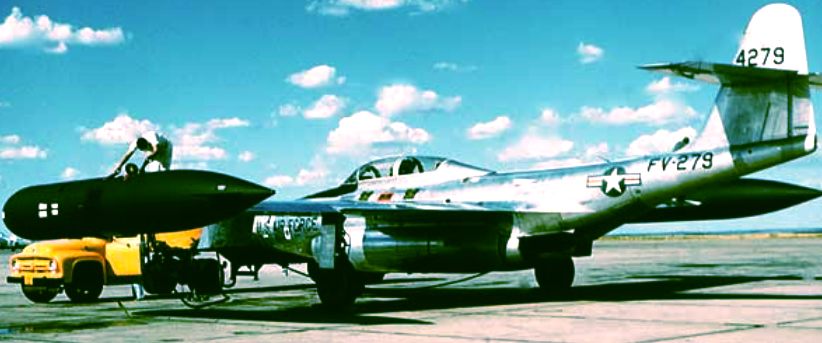
The Northrop F-89 Scorpion was an early American jet-powered fighter aircraft designed from the outset as an all-weather interceptor. Though its straight wings limited its performance, it was among the first USAF jet fighters with guided missiles, and notably the first combat aircraft armed with air-to-air nuclear weapons (the unguided Genie rocket).
Possibly the most capable of the first-generation all weather jet interceptors, the Northrop F-89 was created in response to a USAF proposal for a a successor to the P-61 Black Widow. Entering server in 1950, the clumsy-looking Scorpion actually outlasted its contemporaries, the F-86D Sabre and the F-94
Starfire. During the course of its career the F-89's armament changed from cannons to rockets and
nuclear missiles.
COMPETITION
On March 23, 1945, the USAAF's Requirement Division announced a competition for an all-weather fighter-bomber to guard the northern-most zones of the United States, with particular reference to Alaska where the severe weather conditions led to fighter interceptors being grounded when they should have been ready to defend
American territory against possible attack.
The specification called for an aircraft which was to be the Northrop P-61's immediate successor, a piston-engine fighter, but in December that same year the requirement was changed to stipulate a jet powered aircraft. Bell, Consolidated, Douglas, Goodyear, Northrop and
Curtiss-Wright all entered projects in the con- test and it was Curtiss-Wright whose submission, the four-jet XP-87 (q.v.) found the most favor, in part influenced by the fact that this illustrious company was threatened with closure if it did not win the order. Air Materiel Command also thought highly of John K. Northrop's proposal and in December, 1946, ordered two prototypes, designating them XF-89.
This was the last project on which Northrop himself collaborated before retiring from the day to day running of the business: the design was for a cantilever mid-wing monoplane, with a long, slim, elegant fuselage. In spite of the current trend in designs of that time for a swept-wing, Northrop's designers had opted for an
unswept, laminar flow wing to ensure maximum stability at low speeds, important for a plane which would have to make frequent landings in bad visibility or all-instrument landings.
In the early stages of development, traditional ailerons and flaps were fitted to the wing trailing edge but later replaced by Northrop's patented
"decelerons" which could divide and open up like a clamshell design and which could also function as normal ailerons or as airbrakes when they were fully opened. Removable tip tanks on the wings were an early design feature, later replaced with fixed tanks and eventually by pods containing rockets and fuel.
Two Allison J35-A engines with afterburner were mounted one on either side of the belly of the fuselage, only just under the wings with the air intakes mounted flush in front exactly in line with the engine nacelles. The semimonocoque construction aluminum alloy fuselage had an Al radar and four (later increased to six) 20mm cannons installed in the nose, but the cannons were completely deleted in the D variant, making room for another fuel tank and this version's only armament consisted of rockets.
The pressurized cockpit, seating the pilot and radar observer in tandem was positioned well forwards, had ejector seats and a large bubble canopy. The horizontal tailplanes had been lifted to a position half way up the vertical
tailplane, well out of the way of the exhaust from the afterburners.
The retractable landing gear had unusually large diameter wheels. On August 16, 1946, Fred Bretcher took off from the Edwards AFB runway in the first XF-89 and flight testing began, with mainly positive results but the plane was clearly underpowered. In March, 1949, the plane was officially called the Scorpion (its designation having changed from XP-89 to XF-89 nine months previously), a name suggested by the ground crews at the base who thought the parked plane looked very much like that dangerous creature, crouched and ready to attack.
On July 14, 1949, the USAF decided to order 48 series F-89 aircraft when the Curtiss P-87 program had ground to a halt and to fill the gap until the Scorpion could enter ser- vice, Lockheed's F-94 Starfires (q.v.) were to be used, as they would be available at an earlier date. On February 22, 1950, the first XF-89 crashed while making its 102nd flight but this did not lead to any change in the orders already placed. On June 27 that year John J. Quinn gave the second prototype, designated YF-89A, its maiden flight; this plane differed greatly from the XF-89 which had been destroyed.

SIDE
ELEVATION KEY
A: Throughout their careers, the F-89s remained primarily in natural metal finish. To reduce glare and prevent pilot distraction, the area just forward of the windscreen was painted black.
B: Sitting under the sliding bubble canopy were a pilot and a radar operator. Despite its drawbacks, the F-89 was rock-steady in the air.
C: The 'D' model introduced new armament in the form of the FFAR (folding fin aircraft rockets). Crews were trained to fire these rockets in three salvoes.
D: F-89Ds introduced a longer and slightly slimmer nose profile. The six-cannon arrangement of earlier variants was dispensed with and extra fuel carried in the nose.
E: An unusual feature of the F-89 was its large- diameter main wheels. They were deemed necessary because of the shape of the wing and the F-89's considerable weight.
F: Like the Canadian CF-100 Canuck, the Scorpion featured a mid-mounted tailplane with zero dihedral. The XF 89 had encountered severe turbulence and buffeting at high speeds.

PLAN VIEW KEY
A: Mounting the engines under the fuselage resulted in a high rate of FOD (foreign object damage) and the F- 89 was often referred to as the 'Hoover Model F-89' because of this trait.
B: A major factor in the stability of the Scorpion was its straight, laminar flow wing. lt made take- offs and landings considerably easier.
DESIGN & DEVELOPMENT
Responding to the competition call, Northrop submitted four different designs, prepared by Jack Northrop's team, including a radical flying wing but settled on the N-24, a slim-bodied aircraft with a cantilevered mid-mounted wing and two Allison J35 turbojet engines with afterburners. It was to have radar and a crew of two, with an armament of four 20 mm (.79 in) cannon in a unique trainable nose turret. One of the unusual aspects of the design was the use of Northrop's "Deceleron", a clamshell-style split aileron which could function as a dive brake (like the SBD Dauntless dive bomber's perforated-panel flaps did) or flap as needed on landing approach, that could be accommodated in the slim wing design. The unique feature added to the prototype during development was to become a Northrop trademark, still used today on the B-2 Spirit. Contracts for two prototypes were issued in December 1946, while Douglas with their XF3D-1 Skyknight and Curtiss for their XF-87 Blackhawk prototypes also were awarded development contracts.
The initial XP-89 prototype made its first flight on 16 August 1948, with test pilot Fred C. Bretcher at the
controls. For much of the testing period, Curtiss's entry had been the front-runner for the contract, but in a competition fly-off with its main competitors, the Northrop design proved superior. Other USAF interceptors such as the F-94 Starfire and F-86 Sabre had been adapted from day fighter designs.
OPERATIONS
Production was authorized in January 1949, with the first production F-89A flying in September 1950. It had AN/APG-33 radar and an armament of six 20 mm (.79 in) T-31 cannons with 200 rpg. The swiveling nose turret was abandoned, and 300 US gal (1,100 l) fuel tanks were permanently fitted to the wingtips. Underwing racks could carry 16 5 in (127 mm) aerial rockets or up to 3,200 lb (1,455 kg) of bombs.
Only 18 F-89As were completed, which were mainly used for tests and trials, before the type was upgraded to F-89B standard, with new
avionics. The type entered service with the 84th Fighter-Interceptor Squadron in June
1951. These had considerable problems with engines and other systems, and soon gave way to the F-89C. Despite repeated engine changes, problems persisted, compounded by the discovery of structural problems with the wings that led to the grounding of the F-89 and forced a refit of 194 -A, -B, and -C models.
The major production model was the F-89D, which first flew 23 October 1951 and entered service in 1954. It removed the cannon in favor of a new Hughes E-6 fire control system with AN/APG-40 radar and an AN/APA-84 computer. Armament was two pods of 52 2.75 in (70 mm) "Mighty Mouse" FFAR rockets, for a total of
104. A total of 682 were built.
Proposed re-engined F-89s, designated F-89E and F-89F, were not built, nor was a proposed F-89G that would have used Hughes MA-1 fire control and GAR-1/GAR-2 Falcon air-to-air missiles like the Convair F-106 Delta Dart.
The subsequent F-89H, which entered service in 1956, had an E-9 fire control system like that of the early F-102 and massive new wingtip pods each holding three Falcons (usually three semi-active radar homing GAR-1s and three infrared GAR-2s) and 21 FFARs, for a total of six missiles and 42 rockets. Problems with the fire control system delayed the -H's entry into service, by which time its performance was notably inferior to newer supersonic interceptors, so it was phased out of USAF service by 1959.
The final variant was the F-89J. This was based on the F-89D, but replaced the standard wingtip missile pod/tanks with 600 gal (2,271 l) fuel tanks and fitted a pylon under each wing for a single MB-1 Genie nuclear rocket (sometimes supplemented by up to four conventional Falcon air-to-air missiles). The F-89J became the only aircraft to fire a live Genie as the John Shot of Operation Plumbbob on 19 July 1957. There were no new-build F-89Js, but 350 -Ds were modified to this standard. They served with the Air Defense Command, later renamed the Aerospace Defense Command (ADC), through 1959 and with ADC-gained units of the Air National Guard through 1969. This version of the aircraft was extensively used within the Semi Automatic Ground Environment (SAGE) air defense system.
A total of 1,050 Scorpions of all variants were produced.
SPECIFICATIONS
Crew: 2
Length: 53 ft 9½ in (16.40 m)
Wingspan: 59 ft 8½ in (18.20 m)
Height: 17 ft 6 in (5.33 m)
Wing area: 606 ft² (56.30 m²)
Empty weight: 25,194 lb ()
Max. takeoff weight: 46,638 lb ()
Powerplant: 2 × Allison J35-A-35 afterburning turbojets
Dry thrust: 5,440 lbf (24.26 kN) each
Thrust with afterburner: 7,200 lbf (32.11 kN) each
Performance
Maximum speed: 635 mph (552 knots, 1,022 km/h) at 10,600 ft (3,200 m)
Ferry range: 1,366 mi (1,188 nm, 2,200 km)
Service ceiling: 49,200 ft (15,000 m)
Rate of climb: 7,440 ft/min (37.8 m/s)
Armament
Rockets:
104× 2.75 in (70 mm) "Mighty Mouse" folding-fin aerial rockets
16× 5 in (127 mm) aerial rockets on underwing racks or
Bombs: 3,200 lb (1,500 kg)

ALL
WEATHER
The first successful all-weather fighter to be designed specifically for the role was Northrop's F-89. Outlined in a ProPosal made to the Air Force in December 1945, a development contract was approved in May 1946. The mock-up passed inspection in September, and the first of two prototypes flew on August 16, 1948. The XF-89 carried jettisonable wingtip tanks, but production models had permanent tanks mounted to the tips. The bulbous nose of the prototype was also subject to change on the production planes. The original intent had been to in- stall a Martin nose turret of the type to be used in the Curtiss XF-87, but this was abandoned and conventional nose armament was mounted. Although large, the fuselage was relatively slim, this due to the tandem placement of the crew members. An upswept tail led to the name "Scorpion."
During flight testing, the ailerons on the XF-89 were replaced by a combination aileron/speed brake of the type used on the Flying Wings. Working conventionally as ailerons, the new controls divided top and bottom when used as speed brakes. Called "decelerons" by Northrop, they became standard equipment on all production Scorpions.
Production of the F-89A was approved on July 14, 1949, and 18 of this model were completed before an improved F'898 replaced them on the line. This model differed mainly in internal gear. Both the "A" and "B" models originally carried external balances on the elevators to dampen a high-frequency vibration. They were eliminated by development of an internal balance system. Thirty F'89B's were delivered before the first of 164 "C" types entered production. The first three production models carried six 20 mm cannons in the nose with the radar gear.
In 1951, an F-89B was redesignated YF- 89D and flown with two wingtip pods, each carrying 52 Mighty Mouse rockets plus fuel. Production F-89D's carried these rocket/fuel pods instead of the cannon armament. Six hundred eighty-two of these were built. Additional underwing tanks on the "D" increased its fuel capacity and range. With each model change, there was an accompanying uprating of the engines. The first Scorpion flew with two 4,000 lb. thrust Allison J35-A-15 engines. The F-89D was propelled by a pair of afterburning J35-A-33A's or -41's with 7,200 lbs. maximum thrust. The single YF-898 was an engine test bed.
The final production Scorpion was the F- 89H with tip pods constructed to carry three Hughes Falcon missiles and 2l Mighty Mouse FFAR rockets. An additional six FFAR's could be mounted beneath the wings. Two J35-,4-35's provided the driving force for this model. Modifications to permit launching of Douglas MB-1 Genie missiles changed the designation of 350 "D's" to F-89J's.
The design of the F-89F was a major departure from the Scorpion configuration. Although it reached the mock-up stage, technical problems involving the use of nuclear weapons led to its cancellation. Huge tanks were mounted at the midspan of the wing, these housing the main units of the landing gear, fuel and missiles. The fuselage was faired straight back from the front cockpit and a one-piece stabilizer was attached to the fuselage.
The F-89H has a span of 59 feet 8 inches and a wing area of 650 square feet with rip pods. Overall length is 53 feet 10 inches, height is 17 feet 7 inches. Empty weight is 25,194 pounds and gross weight is 42,241 pounds. The F-89H has a maximum speed of 636 mph at 10,600 feet. Range is 1,300 miles. Service ceiling of the F-89H is 49,200 feet.
LINKS
http://www.fiddlersgreen.net/models/aircraft/Northrop-F89.html





